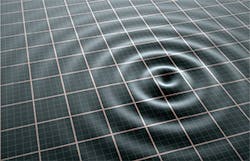It’s one of the slowest-moving problems that water managers are likely to face, yet one that could cost a significant amount of money if left untreated. This money-leaking conundrum seeps along year after year, completely undetected, yet the impact is felt across the service area.
What is this unseen issue? Pipe leaks—an industry-wide frustration that is as old as the industry itself. However, new technologies are trying to remedy the headaches caused by pipe leaks by making detection easier and faster than ever.
Let’s explore the various leak detection methods that range from traditional techniques to high-tech options that allow operators to find leaks without moving an ounce of dirt.
Methods for leak detection include the following:
- Manual inspection following water surfacing
- Listening sticks/acoustic sticks
- Noise correlators
- Advanced metering infrastructure (AMI)
- Satellite detection
Finding water pipe leaks has been a laborious job since the early days of water treatment and water delivery into businesses and homes. When a pipe springs a leak—either from corrosion or from being struck—it might not be obvious right away. The hissing of water as it escapes from metal pipes is quiet, dampened by the dirt and mud around it, and covered by several feet of soil. It can be days, weeks, or even months before that water works its way up to the surface, creating a puddle that is then reported to the city or water management authority. Only then does a crew dig down to that pipe and fix it. Sometimes a patch will do—other times a new pipe is in order. Regardless of the solution, it is always clear that solving this problem much sooner would have prevented damage and the loss of a significant amount of water.
Proper water management has become a lifeline for people across the country whenever droughts cover states. During the Dust Bowl era that lasted from the 1930s to the 1950s, well-pumped water and unlined reservoirs fueled by rain dried up. It’s these reminders of days when irrigation water only fell from the sky that show the life-and-death importance of piped water and maintaining access to that precious supply.
Perhaps water loss due to leaks wasn’t as much of a concern a century ago in regions where piped water was the norm, but today’s droughts in California, the American Southwest, and Wyoming bring the point back home. Every drop of water lost to water pipe leaks could have been allocated to water important crops, used for cooking or drinking, or returned to streams and rivers to maintain ecological health.
Leak detection has been transformed by cloud computing, sensor technology, and the IoT.
Water loss due to pipe leaks can cause significant impacts. James Perry, vice president of business development at Utilis Corp, an Israel-based leak detection company with a US office in San Diego, CA, says industry analysts estimate pipe leaks run unattended 18 months before they’re discovered and fixed. “All of that water loss is significant,” he says.
The consequence isn’t just the lost water. In certain regions, especially in the Rockies and the Appalachians, significant power resources are dedicated to pumping water up high elevations. California alone allocates 20% of its power supply to pumping water, Perry says.
All of that power comes with greenhouse gas costs—both figurative and literal in terms of carbon taxes—and delayed maintenance could require a more expensive fix than if the pipe had been fixed right away.
“Those associated costs are very expensive. Usually it’s not just the cost of water loss,” he says.
David Solomon, founder and CTO at Aquarius Spectrum, an Israel-based water leak detection company, says quick evaluation and resolution of pipe leaks could prevent larger bursts. If a small leak appears, it creates a vulnerability that could turn into a larger burst in the future.
“The most valuable asset of a water utility is its infrastructure,” he says. “Water flows, but the pipes deployed at a very high cost remain. Monitoring the water pipe network on a regular basis is essential for detecting and fixing underground leaks before they develop into large leaks and possibly bursts that cause substantial damage is crucial for maintaining a healthy distribution network.”
Being able to find and fix leaks quicker also can mean better customer service because water suppliers can avoid unexpected water shutoffs necessary when large pipe breaks occur. With more data and more reliable ways to locate leaks, they can be built into regular maintenance schedules without extra customer disruption.
Dave Johnston, director of Echologics, a Canada-based leak detection company owned by Mueller Water Products, adds that preparation and swift responses to pipe leaks can avoid greater trouble down the road. After all, he says, “leaks are inevitable.”
“An effective leak detection program allows water network managers to locate leaks when they are still small and haven’t had a chance to cause a significant amount of damage to the surrounding environment and infrastructure,” says Johnston. “This drives down maintenance cost and decreases non-revenue water loss.”
This is especially true in the US, where water pipes are being used far beyond their expected replacement dates. Perry says developing technology to find water leaks is necessary because replacing water pipes in total is simply too expensive for most municipalities, so water managers have to make do until certain sections of pipes are scheduled for much-needed replacements.
“It’s really based on a need,” he says. ”Metal pipes were made to last about 75 years, and some of them are 100 years old. The overall cost of these systems and maintaining them—it’s too expensive to just replace the pipes—so we’ve had to find alternative ways of dealing with it.”
Leak detection across the US varies drastically in terms of technological ability. The most popular method—waiting for leaks to surface—harkens back to water management methods more than a century ago, says Perry.
He says that worldwide, the way most leaks are found is by just waiting until the water comes up to the surface. The passive approach is cheap in the short-term but very costly in the long-term due to loss of water. Methods developed slightly with the introduction of listening devices.
“Believe it or not, that is the predominant way things are done today, and it goes back to the early 1900s,” he says of listening sticks.
Listening sticks, or acoustic sticks, are made up of a long metal rod with a cylindrical “head” that is typically made up of wood or rubber. The operator sticks the edge of the rod onto a pipe and puts their ear to the head. They then listen for tell-tale sounds that indicate a water leak along that pipe. Sometimes, listening sticks are used to isolate the cause of a reported problem so repair crews will know which water main to check out, especially in dense rural area where water pipes crisscross each block.
Digital versions of listening sticks are also on the market and operators can use them in much the same way to search for sound wavelengths that indicate escaping water. Listening sticks can be used to isolate a leak by finding an area that indicates the loudest sound relative to the other spots measured. Additional methods are typically used after this, such as a correlator.
To use a correlator, microphones or sound sensors are placed onto a pipe at two points to detect and record sound given off by an ongoing leak. The correlator can then pinpoint the location of the leak by running the sound data through an algorithm that evaluates the difference in the sound and frequency of each sensor.
The first acoustic correlators, also known as leak noise correlators, were created in the 1970s. Much like the first personal computers, correlators were 10 or 20 times the size of current models. While a correlator might fit inside a small briefcase today, in the 1970s these instruments were so large that they would take up all the space in the back of a municipal water van.
Palmer Environmental created one of the first leak noise correlators in 1979, according to HWM Water, a United Kingdom-based water and gas leak detection company that now owns Palmer Environmental. This correlator was a giant step for leak detection staff at the time, and correlators continued to get smaller and more efficient over the decades.
While acoustic correlating may seem like a relatively simple solution, it’s a method that has kept cities’ and towns’ water supplies running for decades.
“Acoustic technology has become the most practical and reliable method for monitoring underground water pipe infrastructure on a regular basis,” says Solomon. “In addition to detecting leaks that may have gone undetected for a long period, continuous monitoring and collection of acoustic data from the network allows for the generation of valuable information regarding the sanity of the network and preventive measures that can be taken in order to further improve the water network.”
He adds that in an Aquarius-Spectrum project in Jerusalem, acoustic correlators that were set up to monitor the city’s water network led to the detection of hundreds of underground leaks, which have now been fixed.
“There were two main revolutions in the field of acoustic leak detection. First, the mobile tools for leak detection moved from heavy and expensive equipment to smartphone-based tools that use cloud computing, GPS positioning, and GIS pipe information,” says Solomon. “Another revolution is continuous pipe monitoring with correlating sensor. Cellular communication enables [us] to transmit data that is needed for performing high-quality correlation between sensors.”
Digital and touchscreen correlators came onto the market in the 2010s, bringing correlators into the 21st century. By this point, correlators could detect lower frequencies, were significantly smaller, and delivered results much faster than the earliest iterations of the device. Johnston says correlators have improved significantly and make it possible to find and fix leaks quickly.
“A modern correlating fixed leak detection system is by far the best way to detect leaks in distribution systems,” he says. “It’s non-invasive and non-disruptive and can find leaks long before they are detectable by conventional methods. Through permanent monitoring and notification, it delivers critical information in a timely manner wherever you are, mitigating issues before they escalate and reducing response times to lessen infrastructure damage and water loss.”
Advanced metering infrastructure (AMI) via cloud computing transformed the leak detection industry. AMI uses IoT meters on water meters, gas meters, and electric meters to digitally analyze the efficiency of the entire system. This data is uploaded to a specific server, which uses AMI software, called a Meter Data Management System (MDMS) to analyze the data. Using data from these smart meters, AMI software analyzes the data and determines if a specific line is experiencing an issue. This reveals where a leak could be, and crews go onsite to isolate and fix the leak.
AMI technology has become significantly cheaper since its inception. From 2002 to 2007 alone, AMI technology costs declined by about a fifth, according to the Electric Power Research Institute, a California-based power industry research firm.
Aaron Beasley, vice president of sales at WaterSignal, a Georgia-based leak detection company, says AMI technology has made it possible for cities to track their water use with more specificity. This ability to carefully track water usage is important in an era where cities are seeing more impacts from climate change and cities are implementing initiatives to reduce their water use to protect reservoirs and aquifers.
Atlanta has an ongoing initiative to reduce its water consumption and energy use by 20% by 2020, and AMI and IoT technology give them the data necessary to plan toward that goal, he says. He explains that the introduction of smart meters among their clients—which also text operators when a leak is detected—has made the search for water leaks less complicated, even if the process isn’t perfect.
“We’re starting to see people pay more attention, so there’s a lot more data,” he says. “When you’re looking for a leak, it’s like a needle in a haystack, but if you can identify the haystack, that’s at least a step…. You can’t manage what you can’t monitor.”
The introduction of IoT into leak detection has significantly improved the industry, Johnston says.
“The biggest advance in leak detection technologies in the past few years has been the addition of cellular communication technologies to send large quantities of information quickly without using much power,” he says. “In addition, cloud computing has allowed for large amounts of data to be processed simultaneously. Leak detection has essentially become part of the IoT wave of the smart water utility, enabling operators to monitor and manage their water networks remotely and, most importantly, make the best decisions based on real-time data analysis.”
Solomon adds that IoT is helpful, but data is only as powerful as the data analytics software that comes with it.
“It is important to understand that sensors just provide data; you need advanced big data analytics to detect and predict pipe failure with high reliability,” he says.
The latest development to shake up the world of leak detection is the use of satellite microwave scans to find pipe leaks across an entire municipality. Perry says that his company focuses on this new method. It works by emitting L-band microwaves from a satellite currently in orbit around the Earth.
The microwave bands can penetrate 12 feet underground, he says, and the waves bounce back to the satellite, which sends information to Utilis Corp for analysis. The method detects underground water signatures, making it possible to find every significant water leak in a large area at once. The satellite orbits Earth once every 14 days.
Perry says he’s seen more interest in the technology in California, especially since a 2015 state law required state utility companies to report water loss. In Duarte, CA, near Los Angeles, a satellite scan revealed dozens of leaks that needed fixing.
“We found a huge number of leaks, something in the order of 70 leaks,” he says. “That’s a huge amount of water recovery.”
Perry says the concept of “smart cities” hasn’t been robustly deployed, so market solutions like satellite scanning aim to fill that need.
“Aggressive start-up innovation fills that void [through] unique ways of looking at it,” he says. “We’re able, with multiple technologies, to get a handle and manage the system attributes, as well as look for breakdowns.”
Other creative methods, like adding cameras inside meters, have proven helpful to customers, Beasley says. This method uses time-lapse photography to figure out when the meter is spinning
—to evaluate a timeframe for particularly tricky cases.
He says a client once had an issue with their water bill staying high, even after reduction measures had taken place. The manager of an apartment complex had seen a $20,000 increase in his water bill in the past few weeks. Beasley’s company was able to figure out that the apartment complex normally used just 3 gallons of water per unit, but at 3 a.m. the usage jumped to a whopping 8 gallons of water per unit every day. The combined increase meant the complex was using 2,500 gallons a day.
The complex manager inspected the units and discovered that scores of his college-age tenants hadn’t noticed or had failed to report the fact that their toilets were leaking often at night—whoops! The fix was able to significantly reduce the complex’s water bill and water usage, and the manager was able to breathe a sigh of relief.
Perry says at the end of the day, all of these methods work together to produce a robust solution for finding water pipe leaks.
“All of them complement each other. It’s really like several arrows in your quiver,” he says.
Beasley says all of these methods to detect leaking water are essential to avoid wasting the precious resource of fresh, potable water. In today’s world, water may be taken for granted by some people, but water managers and utility staff are all too aware how prized this resource has become over the past years.
“Water is not a renewable resource,” he says. “If we’re not careful, then we’ll be up the creek without a paddle.”
As the effects of climate change have made water conservation a reality—both due to drought and due to saltwater intrusion into freshwater aquifers—environmentally conscious customers have made personal goals to reduce their water usage. These personal goals give customers the feeling of ownership of the problem, and data analytics give them the feedback necessary to know whether they’re meeting their goals.
Beasley says some medical facilities and schools that are clients have been excited to see how much water they’re able to save once they can find the weak links in their water-saving chain. He says it gives users a sense of pride about their environmental impact.
Sometimes, leak detection is a water pipe that’s broken, but sometimes it’s from a toilet, a faulty AC unit, or even a bathroom tap that’s been running for two days straight. Once customers have a detective tool to solve these water-wasting mysteries, they feel more empowered, he says.
They also like the fact that their water bill decreases, especially if their state or city has enacted drought-related fines on maximum water usage. The ability to decrease water also gives customers a success story that they can boast about in their marketing and public relations campaigns.
“We’re giving our end-users the ability to monitor and manage their water consumption. It does give you a different picture of where your water is going,” he says. “They start to get really excited about how much water they’re saving…. Efficiency comes into place with leak detection. Not only is it helpful to the planet, but we’re also helping people save money.”


